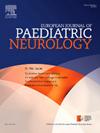Neurodevelopmental outcomes at age 5 years among children born very preterm and surviving after persistent pulmonary hypertension of the newborn: EPIPAGE-2 cohort study
IF 2.3
3区 医学
Q3 CLINICAL NEUROLOGY
引用次数: 0
Abstract
Objective
To determine whether pulmonary hypertension (PH) is associated with higher risk of adverse neurodevelopmental outcome at age 5 in a population-based cohort of 22–31+6 preterm children.
Study design
In the EPIPAGE-2 French prospective population-based cohort of preterm children born in 2011, the neurodevelopmental outcome of children with PH was collected at 5 years. The primary outcome was a composite measure with four levels of neurodevelopmental disabilities: severe, moderate, mild, no disability, based on cerebral palsy, visual, hearing or cognitive deficiencies, behavioral difficulties and developmental coordination disorders. Secondary outcomes were autism spectrum disorders and school attendance. Missing data were multiply imputed. Developmental measures were compared using generalized estimating equations models.
Results
Of the 3007 eligible children, 1825 were analyzed, of whom 79 (4.3 %) were PH+. At age 5, 36.9 % (95 % CI, 26.0–47.8) of PH + children had moderate to severe overall neurodevelopmental disabilities compared with 17.9 % (95 % CI, 16.1–19.8) of PH–children, P < 0.001. Significant differences at 5 years between the PH+ and PH– groups were observed for cerebral palsy (CP) (6 % versus 2.3 % for severe CP, P = 0.003), cognitive deficiency (31.7 % versus 15.0 %, P < 0.001) and developmental coordination disorders (27.1 % versus 11.7 %, P < 0.001). There were no significant differences in behavioral difficulties and autism spectrum disorders. Normal school was attended by 69.2 % of PH + children versus 88.3 % of PH– children.
Conclusion
In this nationwide population-based cohort of extremely preterm and very preterm infants, moderate to severe overall neurodevelopmental disability at age 5 was significantly associated with neonatal PH.
EPIPAGE-2队列研究:非常早产和新生儿持续性肺动脉高压后存活的5岁儿童的神经发育结局
目的在22-31 +6早产儿人群队列中,确定肺动脉高压(PH)是否与5岁时不良神经发育结局的高风险相关。在2011年出生的早产儿EPIPAGE-2法国前瞻性人群队列中,收集了5岁时PH患儿的神经发育结局。主要结果是一项综合测量,包括四个级别的神经发育障碍:严重、中度、轻度、无残疾,基于脑瘫、视觉、听觉或认知缺陷、行为困难和发育协调障碍。次要结果是自闭症谱系障碍和出勤率。对缺失数据进行多重输入。采用广义估计方程模型对发展指标进行比较。结果3007例符合条件的儿童中,1825例被分析,其中79例(4.3%)为PH+。在5岁时,36.9% (95% CI, 26.0-47.8)的PH +儿童有中度至重度整体神经发育障碍,而PH -儿童为17.9% (95% CI, 16.1-19.8), P <;0.001. 5年时,PH+组和PH -组在脑瘫(CP)(6%对2.3%,P = 0.003)、认知缺陷(31.7%对15.0%,P <;0.001)和发育协调障碍(27.1%对11.7%,P <;0.001)。在行为困难和自闭症谱系障碍方面没有显著差异。接受师范教育的PH +儿童占69.2%,PH -儿童占88.3%。结论:在这个以全国人口为基础的极早产儿和极早产儿队列中,5岁时中度至重度整体神经发育障碍与新生儿PH显著相关。
本文章由计算机程序翻译,如有差异,请以英文原文为准。
求助全文
约1分钟内获得全文
求助全文
来源期刊
CiteScore
6.30
自引率
3.20%
发文量
115
审稿时长
81 days
期刊介绍:
The European Journal of Paediatric Neurology is the Official Journal of the European Paediatric Neurology Society, successor to the long-established European Federation of Child Neurology Societies.
Under the guidance of a prestigious International editorial board, this multi-disciplinary journal publishes exciting clinical and experimental research in this rapidly expanding field. High quality papers written by leading experts encompass all the major diseases including epilepsy, movement disorders, neuromuscular disorders, neurodegenerative disorders and intellectual disability.
Other exciting highlights include articles on brain imaging and neonatal neurology, and the publication of regularly updated tables relating to the main groups of disorders.

 求助内容:
求助内容: 应助结果提醒方式:
应助结果提醒方式:


